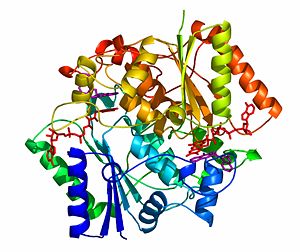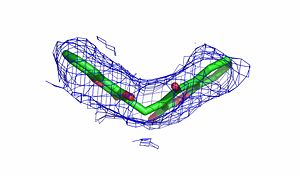NADH quinone oxidoreductase (NQO1) with inhibitor dicoumarol
From Proteopedia
(Difference between revisions)
m (Nqo1 moved to NADH quinone oxidoreductase (NQO1) with inhibitor dicoumarol: old title was obscure to most users) |
|||
| (24 intermediate revisions not shown.) | |||
| Line 1: | Line 1: | ||
| + | <StructureSection load='2f1o.pdb' size='350' frame='true' side='right' scene='2f1o/Com_view/2' caption='NADPH dehydrogenase complex with FAD and dicoumarol [[2f1o]]'> | ||
== The crystal structure of NADH quinone oxidoreductase (NQO1) in complex with its potent inhibitor dicoumarol == | == The crystal structure of NADH quinone oxidoreductase (NQO1) in complex with its potent inhibitor dicoumarol == | ||
| - | NAD(P)H quinone oxidoreductase 1 (NQO1) is a ubiquitous flavoenzyme that catalyzes two electron reduction of quinones to hydroquinones utilizing [[NAD(P)H]] as an electron donor. | + | [[Image:NQO_Dic copy.jpg|border|left|300px]] |
| - | NQO1 is a homo-dimer that functions via a “ping pong” mechanism. | + | {{Clear}} |
| - | Certain coumarins, flavones and the reactive dye cibacron blue are competitive inhibitors of NQO1 activity, which compete with NAD(P)H for binding to NQO1. [[Dicoumarol]] (3-3’–methylene-bis (4-hydroxycoumarin))[[Image:Figure3 copy.jpg|border|center|300px]] | + | [http://en.wikipedia.org/wiki/NAD(P)H_dehydrogenase_(quinone) NAD(P)H quinone oxidoreductase 1] (NQO1, [http://www.expasy.org/cgi-bin/nicezyme.pl?1.6.5.2 EC 1.6.5.2]) is a ubiquitous [http://medical-dictionary.thefreedictionary.com/flavoenzyme flavoenzyme] that [http://en.wikipedia.org/wiki/Catalysis catalyzes] two electron reduction of [http://en.wikipedia.org/wiki/Quinone quinones] to [http://en.wikipedia.org/wiki/Hydroquinone hydroquinones] utilizing [[NAD(P)H]] as an [http://en.wikipedia.org/wiki/Electron_donor electron donor]. |
| - | In addition to its role in the detoxification of quinones, NQO1 is also a 20S proteasome-associated protein that plays an important role in the stability of the tumor suppressor p53 and several other short-lived proteins including [[p73α]] and ornithine decarboxylase ([[ | + | NQO1 is a homo-dimer that functions via a “ping pong” mechanism. NAD(P)H binds to NQO1, reduces the [http://en.wikipedia.org/wiki/FAD FAD] co-factor and is then released, allowing the quinone substrate to bind the enzyme and to be reduced. The NAD(P)H and the quinone binding sites of NQO1 have a significant overlap, thus providing a molecular basis for this “ping pong” mechanism. |
| - | < | + | Certain [http://en.wikipedia.org/wiki/Coumarin coumarins], [http://en.wikipedia.org/wiki/Flavones flavones] and the reactive dye cibacron blue are [http://en.wikipedia.org/wiki/Competitive_inhibition competitive inhibitors] of NQO1 activity, which compete with NAD(P)H for binding to NQO1. [[Dicoumarol]] (3-3’–methylene-bis (4-hydroxycoumarin)),[[Image:Figure3 copy.jpg|border|center|300px]] is the most potent competitive inhibitor of NQO1. Dicoumarol competes with NAD(P)H for binding to NQO1 and prevents the [http://en.wikipedia.org/wiki/Electron_transfer electron transfer] to FAD. |
| - | The crystal structure of human<scene name='Nqo1/Nqo1_1/2'>NQO1</scene> in complex with dicoumarol was determine at 2.75 Å resolution. | + | In addition to its role in the detoxification of quinones, NQO1 is also a 20S proteasome-associated protein that plays an important role in the stability of the [http://en.wikipedia.org/wiki/Tumor_suppressor_gene tumor suppressor] p53 and several other short-lived proteins including [[p73α]] and ornithine decarboxylase (ODC, ''i.e.'' [[7odc]]). NQO1 binds and stabilizes [[p53]], protecting p53 from [http://en.wikipedia.org/wiki/Proteasome#Ubiquitin-independent_degradation ubiquitin-independent 20S proteasomal degradation]. Dicoumarol and several other inhibitors of NQO1 activity, which compete with NADH for binding to NQO1, disrupt the binding of NQO1 to p53 and induce ubiquitin-independent p53 degradation. |
| + | |||
| + | The crystal structure of human NQO1 in complex with dicoumarol was determined at 2.75 Å resolution ([[2f1o]]). NQO1 is a <scene name='2f1o/Com_view/6'>physiological homodimer</scene> composed of two interlocked monomers. <scene name='2f1o/Com_view/7'>Two catalytic sites</scene> are formed and are present at the dimer interface (<font color='red'><b>FAD is colored red</b></font> and <font color='blue'><b>dicoumarol is colored blue</b></font>). Therefore, each from these two <scene name='2f1o/Active_site/3'>dicoumarol-hNQO1 binding sites</scene> is formed by both monomers. <font color='cyan'><b>Dicoumarol is colored cyan</b></font>, <font color='orange'><b>FAD in orange</b></font>, nitrogens and oxygens are shown in [http://en.wikipedia.org/wiki/CPK_coloring CPK colors]. NQO1 <font color='blueviolet'><b>chain A is colored blueviolet</b></font> and <font color='lime'><b>chain C in lime</b></font>. NQO1 residues, participating in ligand interactions, are shown as stick representation and are labeled (A and C refer to the NQO1 chains). H-bonds are shown by dashed lines with their distances. | ||
| + | {{Clear}} | ||
| + | |||
| + | |||
| + | <scene name='2f1o/Align/8'>Structural comparison</scene> of the active site of <font color='magenta'><b>dicoumarol/hNQO1 complex</b></font> (residues important for ligand interactions are <font color='magenta'><b>colored magenta</b></font>) with that of <font color='blue'><b>apo hNQO1</b></font> dimer ([[1d4a]], residues important for ligand interactions are <font color='blue'><b>colored blue</b></font>) reveals that structural changes associated with dicoumarol binding occur on several residues involving both monomers. <font color='cyan'><b>Dicoumarol is colored in cyan</b></font>; <font color='orange'><b>FAD is colored in orange</b></font>. The RMSD between the apo hNQO1 ([[1d4a]]) and hNQO1 in complex with dicoumarol is 0.36Å for the 546 Cα atoms. The dicoumarol-hNQO1 binding causes several structural changes. The most prominent of them is Tyr 128 and Phe 232 movement in the first monomer. These residues are located on the surface of the NQO1 catalytic pocket. The <scene name='2f1o/Align/9'>distance</scene> between these residues increases from ~5 Å in the <font color='blue'><b>apo hNQO1</b></font> to ~12 Å in the <font color='magenta'><b>dicoumarol/hNQO1 complex</b></font>. | ||
| + | Quinones (including duroquinone (2,3,5,6-tetramethyl-''p''-benzoquinone) are substrates of NQO1 (it catalyzes two-electron reduction of them to hydroquinones). Duroquinone <font color='black'><b>(yellow)</b></font> binds to the <scene name='2f1o/Align1/4'>active site</scene> by interactions involving the FAD and several hydrophobic and hydrophilic residues in the duroquinone-NQO1 complex ([[1dxo]]). The structure of the hNQO1 dimer in complex with duroquinone is also similar to that of hNQO1 in complex with dicoumarol (RMSD is 0.33Å for the 546 Cα atoms). In this case, the main differences between these two structures, as well as to that of apo hNQO1, involve the distance between residues <scene name='2f1o/Align1/5'>Tyr 128 and Phe 232</scene> of the first monomer. The FAD molecule has very similar conformation in both hNQO1-duroquinone <font color='pink'><b>(pink)</b></font> and hNQO1−dicoumarol <font color='orange'><b>(orange)</b></font> complexes. Based on the comparison of NQO1 structure in complex with different NQO1 inhibitors and our previous analysis of NQO1 mutations that affect NQO1 interactions we propose that the specific conformation of Tyr 128 and Phe 232 is important for NQO1 interaction with p53 and other client proteins. | ||
| + | |||
| + | {{Clear}} | ||
| + | |||
| + | <!-- | ||
| + | |||
| + | The crystal structure of human <scene name='Nqo1/Nqo1_1/2'>NQO1</scene> in complex with dicoumarol was determine at 2.75 Å resolution. | ||
NQO1 is a physiological homodimer composed of two interlocked monomers. Each monomer is composed of two domains: a large catalytic domain with α/β fold with flavodoxin topology (residues 1-220) and a small C-terminal domain (residues 221-273). Two catalytic sites are formed and are present at the dimer interface. Two FAD molecules (red) are present; each one is bound to the catalytic domain of each monomer. The dicoumarol molecule (purple) is bound to each of the catalytic sites interacting with FAD and with residues from both monomer.The dicoumarol molecule is bound to each of the catalytic sites interacting with FAD and with residues from both monomers. | NQO1 is a physiological homodimer composed of two interlocked monomers. Each monomer is composed of two domains: a large catalytic domain with α/β fold with flavodoxin topology (residues 1-220) and a small C-terminal domain (residues 221-273). Two catalytic sites are formed and are present at the dimer interface. Two FAD molecules (red) are present; each one is bound to the catalytic domain of each monomer. The dicoumarol molecule (purple) is bound to each of the catalytic sites interacting with FAD and with residues from both monomer.The dicoumarol molecule is bound to each of the catalytic sites interacting with FAD and with residues from both monomers. | ||
| - | + | ||
Structural comparison of the apo hNQO1 dimer (PDB accession code 1D4A in cyan) with hNQO1 in complex with dicoumarol(pink) reveals that structural changes associated with dicoumarol binding occur on several residues involving both monomers. The most prominent conformational changes that occur in the presence of dicoumarol involve Tyr 128 and Phe 232 that are present on the surface of the NQO1 catalytic pocket. Based on the comparison of NQO1 structure in complex with different NQO1 inhibitors and our previous analysis of NQO1 mutations that affect NQO1 interactions we propose that the specific conformation of Tyr 128 and Phe 232 is important for NQO1 interaction with p53 and other client proteins. | Structural comparison of the apo hNQO1 dimer (PDB accession code 1D4A in cyan) with hNQO1 in complex with dicoumarol(pink) reveals that structural changes associated with dicoumarol binding occur on several residues involving both monomers. The most prominent conformational changes that occur in the presence of dicoumarol involve Tyr 128 and Phe 232 that are present on the surface of the NQO1 catalytic pocket. Based on the comparison of NQO1 structure in complex with different NQO1 inhibitors and our previous analysis of NQO1 mutations that affect NQO1 interactions we propose that the specific conformation of Tyr 128 and Phe 232 is important for NQO1 interaction with p53 and other client proteins. | ||
| + | --> | ||
| + | |||
| + | The quinone ES936 causes irreversible inhibition of the NQO1. <scene name='2f1o/Align2/5'>Alignment</scene> of the hNQO1 dimer in complex with <font color='red'><b>ES936 (red)</b></font> ([[1kbq]]) with the hNQO1−dicoumarol complex ([[2f1o]]) yields 0.45Å RMSD for the 546 Cα atoms. The ES936 causes structural change only in the position of Phe 232. The movement of this residue is smaller than that caused by dicoumarol. The <scene name='2f1o/Align2/6'>distance</scene> between Tyr 128 and Phe 232 in the hNQO1−ES936 complex is only ~7 Å, while in the hNQO1−dicoumarol complex it is ~12 Å. | ||
| + | </StructureSection> | ||
| + | ==3D structures of NQ01== | ||
| - | [[ | + | [[Quinone reductase]] |
| + | ==Additional Resources== | ||
| + | For additional information, see: [[Carbohydrate Metabolism]] | ||
| + | <br /> | ||
| - | === | + | ==References== |
| + | <ref group="xtra">PMID:10706635</ref> <ref group="xtra">PMID:16700548</ref> <references group="xtra"/> | ||
| + | [[Category: Homo sapiens]] | ||
| + | [[Category: Single protein]] | ||
| + | [[Category: Adler, J.]] | ||
| + | [[Category: Asher, G.]] | ||
| + | [[Category: Dym, O.]] | ||
| + | [[Category: Shaul, Y.]] | ||
| + | [[Category: Tsvetkov, P.]] | ||
| + | [[Category: ISPC]] | ||
| + | [[Category: Israel Structural Proteomics Center]] | ||
| + | [[Category: Oxidoreductase]] | ||
| + | [[Category: Protein inhibitor]] | ||
| + | [[Category: Structural genomic]] | ||
Current revision
| |||||||||||
3D structures of NQ01
Additional Resources
For additional information, see: Carbohydrate Metabolism
References
- Faig M, Bianchet MA, Talalay P, Chen S, Winski S, Ross D, Amzel LM. Structures of recombinant human and mouse NAD(P)H:quinone oxidoreductases: species comparison and structural changes with substrate binding and release. Proc Natl Acad Sci U S A. 2000 Mar 28;97(7):3177-82. PMID:10706635 doi:http://dx.doi.org/10.1073/pnas.050585797
- Asher G, Dym O, Tsvetkov P, Adler J, Shaul Y. The crystal structure of NAD(P)H quinone oxidoreductase 1 in complex with its potent inhibitor dicoumarol. Biochemistry. 2006 May 23;45(20):6372-8. PMID:16700548 doi:10.1021/bi0600087
Proteopedia Page Contributors and Editors (what is this?)
Alexander Berchansky, Orly Dym, Michal Harel, Jaime Prilusky, Moshe Ben-David, Joel L. Sussman, David Canner, Eric Martz


